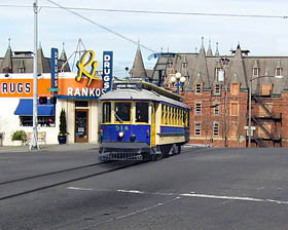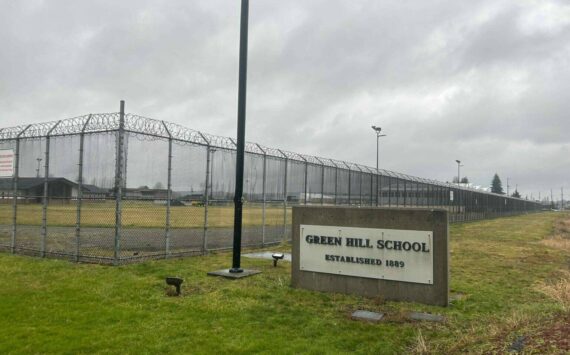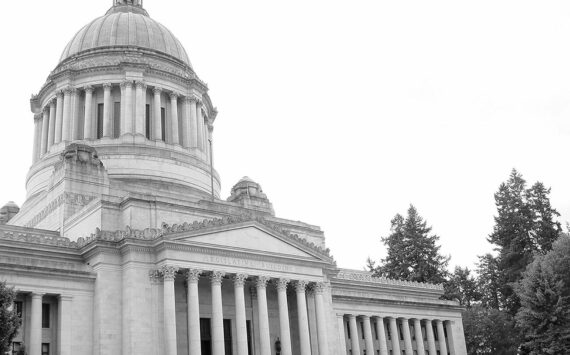A Tacoma City Council committee yesterday voted to accept findings of a recent feasibility study that examines the idea of restoring a heritage streetcar system to the city.
The decision came during a presentation at City Hall to members of the city’s environment and public works committee, and is the latest development in a grassroots movement that has pulled together representatives from Sound Transit, Pierce Transit, Tacoma-Pierce County Chamber, neighborhoods, and business districts to study the costs and possible routes associated with building one or more streetcar lines.
“Clearly, if 100 years ago we could do this, we could do it now,” said Steve Shanafelt, Tacoma public works engineering division manager, who was tasked with leading the team, and presented the study’s findings.
Shanafelt provided examples of three possible streetcar routes that would largely follow original lines that once existed in Tacoma: the 6.32-mile Sixth Avenue line would stretch from Link Light Rail’s Theater District stop near South Ninth St. and Commerce to Sixth Ave. and Madison Ave.; the 10.36-mile Downtown line would zig-zag from 23rd St. and J St. down the hillside and through downtown, ending near Broadway and Tacoma Ave.; and the 5.12-mile Portland / Salishan line would stretch from Tacoma Dome Station to Portland Ave. and 48th St.
Still, Shanafelt cautioned that these were simply suggested routes created by the feasibility group, and based on connections to Link Light Rail, transit ridership volumes in those areas, and development activity along those lines.
“I want to make sure you understand this is not a proposal about where routes should be,” he said. “There needs to be extensive public outreach and more stakeholders involved regarding route selection.”
The biggest hurdle, however, remains financing, according to the study.
The costs of streetcar lines and light rail in other cities have ranged from $11.6 million per mile (Portland, Ore.) to $22.2 million per mile (Atlanta) to $46 million per mile (Denver). The feasibility group recommended reducing costs by creating routes that share roads with vehicle traffic, selecting restored heritage cars that would be much cheaper than new models, and starting with a single, prioritized route rather than a complex system.
“Unless you can come up with a great big pot of money at once, this should be prioritized,” Shanafelt added.
Still, other U.S. cities have turned to streetcars to spur economic development.
In Kenosha, Wis., which started operating a two-mile line in 2000, the return on investment has been substantial. According to a study conducted by Reconnecting America, a national non-profit organization formed to link transportation networks and the communities they serve, the system, which cost $6 million, has seen $150 million in planned and existing development directly related to the line (67,500 people rode the streetcar in 2005). In Little Rock, Ark., a 2.5-mile, $19.6 million line has seen $200 million in development investment (ridership totaled 190,000 in 2005). And in Tampa, Fla., a $48.3 million, 2.3-mile line has seen $1 billion in investment tied to its 2003 operation (ridership totaled 435,000 in 2005).
In Portland, streetcars have “been highly instrumental in focusing development in areas where streetcars are located,” said Shanafelt. “Developers are much more willing to invest their own money. We see it as a strong economic development tool.”
Tacoma’s history is inextricably linked to streetcars.
According to History Link, an online encyclopedia of Pacific Northwest history, streetcar roots date as far back as 1885, when businessman Allen C. Mason made a request to City Council for 30-year franchise to build a streetcar system. That request was denied. But in 1887, railroad contractor Nelson Bennett made a similar request, lobbying for a 50-year franchise. Permission was granted, and the City of Tacoma built the tracks. Bennetts steam locomotives were franchised out to real estate promoters who wanted to serve new housing developments in the citys south and west ends, according to History Link. Bennett eventually sold his company, which was renamed Tacoma Railway & Motor Company. Steam locomotives were upgraded to electric power, and the first electric streetcar ran on Feb. 10, 1890.
Yesterday’s presentation followed a long route, dating back to last spring, for the streetcar idea through City Hall.
On April 12, 2006, the environment and public works committee unanimously approved a do-pass recommendation to City Council for a resolution to study the feasibility of developing the streetcar. On July 27, 2006, City Council agreed with that recommendation and unanimously passed a resolution directing city staff to study the idea.
Tacoma resident Morgan Alexander, who has spearheaded the streetcar movement, was pleased with yesterday’s discussion and hoped to see more action taken to build and restore a line. “The city just needs to really act on this and not study it to death,” he said. “The longer we wait, the more expensive it will get.”
– – – – – – – – – – – – – – – – – – – –
For images of three proposed streetcar lines presented in the feasibility study, visit http://www.tacomadailyindex.com/pages/streetcar/
1. st_downtown.jpg — 10.36-mile Downtown line
2. st_portland_salishan.jpg — 5.12-mile Portland / Salishan line
3. st_sixth_ave.jpg — 6.32-mile Sixth Avenue line
– – – – – – – – – – – – – – – – – – – –
For earlier coverage of the Tacoma Streetcar plan in the Index, visit the newspaper’s archives online for the following articles:
— Streetcar Desires: Tacoma isn’t the only city giving heritage transportation a new look (Jan. 17, 2007); also here: http://www.wahmee.com/streetcar.html
— Group kicks off feasibility study for Tacoma streetcar (Dec. 19, 2006)
— Home Town Spirit: An interview with Tacoma Streetcar’s Morgan Alexander (Sept. 19, 2006)
— City moves forward on streetcar feasibility study (June 28, 2006)
— Council committee supports streetcar resolution (April 13, 2006)








